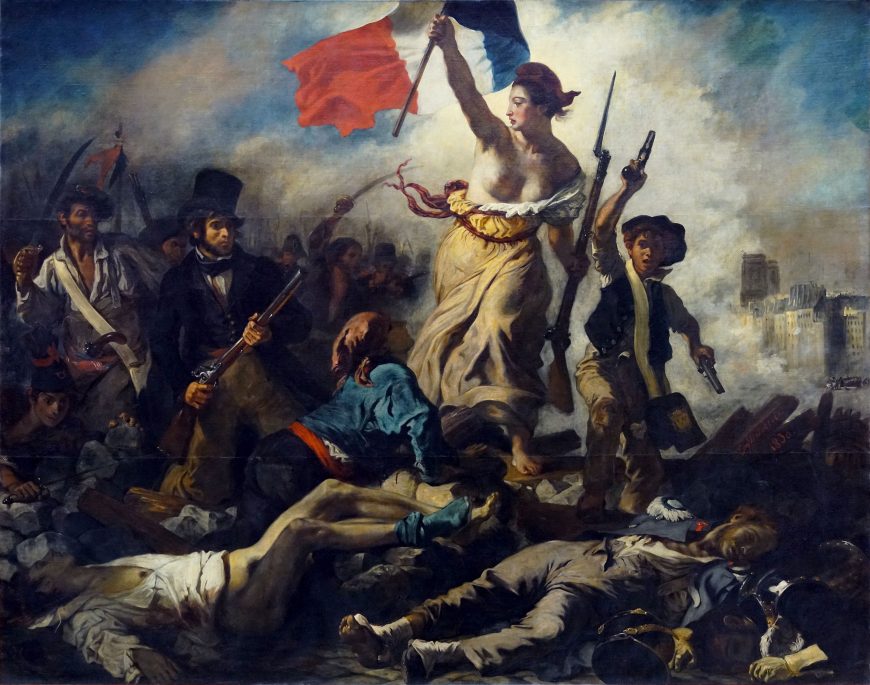WA5. The French Revolution and Art¶
Statement¶
In an essay, discuss the effect of the French Revolution on painting and/or sculpture during this time. Include a discussion of at least one painting or sculpture from both the Neoclassical period as well as the Romantic. Your discussion should focus on the connection the work of art had to the Revolution itself.
Answer¶
Introduction¶
The French Revolution from 1789 to 1799 was a period of significant changes on every side of society from politics to art. The Revolution started as a demand for political and social reforms, but it quickly turned into a bloody conflict that led to the fall of the monarchy and the rise of the Republic. The Revolution had a strong impact on art, inspiring artists to create works that reflected the revolutionary spirit and the new ideas of liberty, equality, and fraternity.
The art reflected every stage of the Revolution; in the beginning, it was enthusiasm, optimism, and excitement as artists pictured people marching and uprising in the streets. Later, the art became darker and more violent as the Revolution took the blood path with extreme violence, and artists also celebrated hope, patriotism, and justice. Then, at a later stage, the art conveyed the desire to return to order and normality and even celebrate the rise of Napoleon Bonaparte (Exploring Powerful French Revolution Paintings in Art, 2023).
Neoclassicism and the French Revolution¶
Neoclassicism was an art movement that emerged in the late 18th century as a reaction against the individualism and less-important subjects of the Rococo style; the movement was inspired by the Roman and Greek cultures and wanted to bring their virtues of glorifying the personal sacrifice for the nation, conveying discipline and order, and spreading good morals (18th- and 19th-Century France, 2024).
Neoclassical artists believed that art should be rational, orderly, and moral, and they used classical forms and themes to express their ideas. The French Revolution had a significant impact on Neoclassicism, as artists saw it as an opportunity to create art that reflected the revolutionary ideals of liberty, equality, and fraternity.
An example of a Neoclassical painting that reflects the French Revolution is “The Oath of the Horatii” by Jacques-Louis David. The painting depicts a scene from Roman history in which three brothers swear an oath to defend Rome against its enemies. The painting was created in 1784, five years before the start of the French Revolution, but it became a symbol of the revolutionary spirit as it conveyed the idea of self-sacrifice for the nation and the importance of duty and honor (Taylor, 2019).
 |
|---|
| The Oath of the Horatii by Jacques-Louis David (Tylor, 2019) |
Romanticism and the French Revolution¶
Romanticism was a reaction against the rationalism of the Enlightenment and the imposed scientific nature of art. Romantic artists believed that art should be emotional, imaginative, and expressive, and they used dramatic themes and bold colors to convey their ideas (Jones, 2024).
Romanticism celebrated intimacy, spirituality, and beauty. The French Revolution appeared in the Romantic art of that era; the painting “Liberty Leading the People” by Eugène Delacroix is a good example of this style. The painting depicts a top-naked woman holding the French flag and leading a group of people in a revolutionary uprising. The painting was created in 1830, during the July Revolution in France, and it became a symbol of the revolutionary spirit as it conveyed the idea of freedom, courage, and hope (McCoy, 2023).
 |
|---|
| Liberty Leading the People by Eugène Delacroix (McCoy, 2023) |
Conclusion¶
The French Revolution had a significant impact on art, as it has on every aspect of society, inspiring artists to create works that reflected the revolutionary spirit and the new ideas of liberty, equality, and fraternity. Neoclassicism wanted to bring back the virtues of the classical ages, while Romanticism wanted to bring back the emotional and expressive nature of art. However, both movements were influenced by the events of the Revolution and the emotions in artworks were a reflection of the revolutionary spirit and political scene of the time.
References¶
- 18th- and 19th-Century France — Neoclassicism. (2024). Nga.gov. https://www.nga.gov/features/slideshows/18th-and-19th-century-france-neoclassicism.html
- Exploring Powerful French Revolution Paintings in Art | 1st Art Gallery. (2023). 1st-Art-Gallery.com. https://www.1st-art-gallery.com/article/exploring-powerful-french-revolution-drawings-in-art/
- Jones, M. (2024). Romanticism. Pressbooks.pub; Pressbooks. https://boisestate.pressbooks.pub/arthistory/chapter/romanticism/
- Taylor K. (2019, September 22). 1.2: Neoclassicism and the French Revolution. Humanities LibreTexts. https://human.libretexts.org/Bookshelves/Art/Western_Art_from_18th_to_Mid-20th_Century_(Taylor)/01%3A_Chapters/1.02%3A_Neoclassicism_and_the_French_Revolution
- McCoy C. (2023). Khanacademy.org. https://www.khanacademy.org/humanities/becoming-modern/romanticism/romanticism-in-france/a/romanticism-in-france